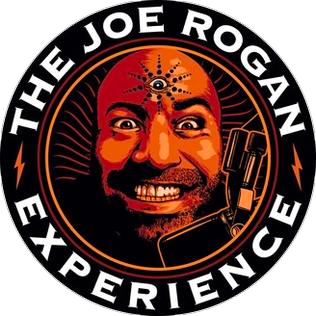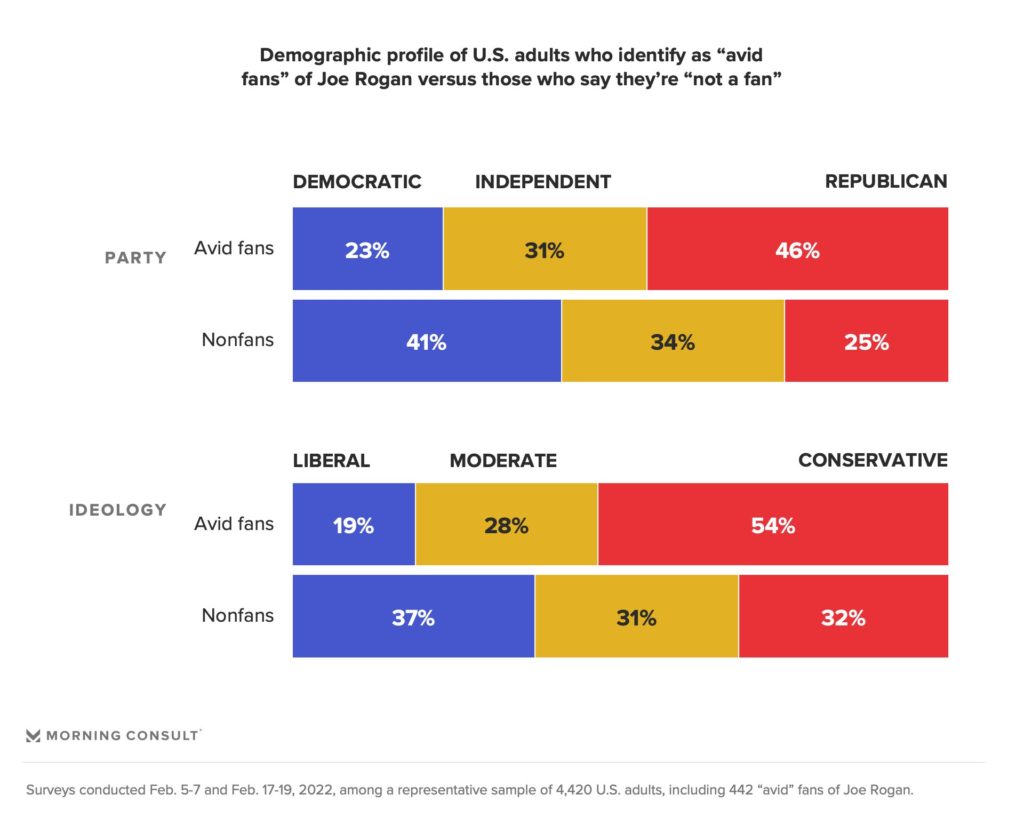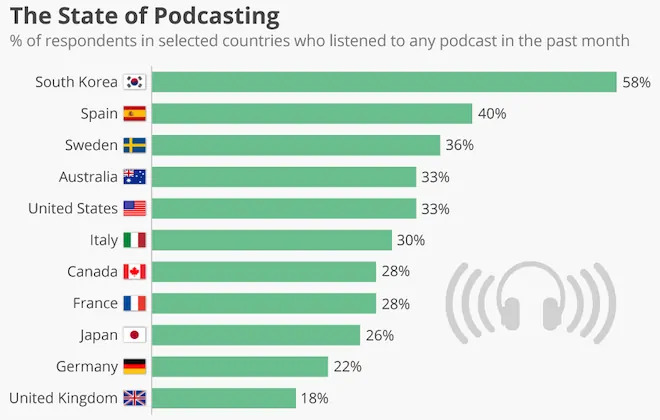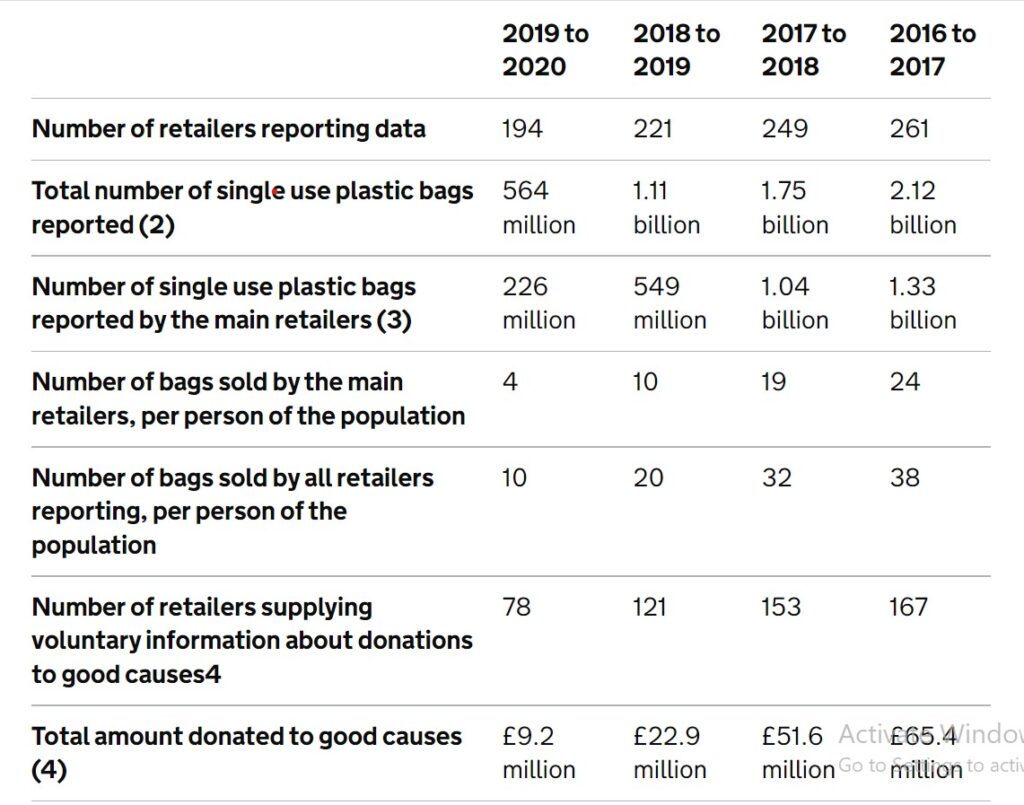- The Joe Rogan Experience

The Joe Rogan Experience was started by Joe Rogan. UFC Color Commentator, Comedian and Presenter.
The Joe Rogan Experience first launched on December 29,2009 with Co Host Brain Redman Accumulating 11 Million Viewers and 200 Million dollars. Becoming the #1 Podcast, The Joe Rogan Experience. Celebrities and historical figures like David Goggin’s, Elon Musk, Jordan Peterson and Iron Mike Tyson have talked on their personal life and numerous intriguing topics. Some of the topics include Mental Health, World News, Politics, Sports, Comedy and much more.
Joe Rogan’s audience and there most common age range listened/viewed is difficult to find, Where as Unherd.com says:
“The first thing that stands out is that they’re heavily male — 72% of the avid fans are men compared to just 42% of the non-fans. They’re also young. 46% of the avid fans are aged between 18 and 34, and a further 23% between 35 and 44. The equivalent figures for the non-fans are 26% and 14%.
As for race, the majority of avid fans are white (64%), but that’s a slightly lower proportion than among the non-fans (67%). Furthermore 25% of the avid fans are Hispanic (the figure for the non-fans is 15%) .
The majority of the supporter’s of The Joe Rogan Experience and Joe Rogan himself are substantially adult Republicans with a mass of 46%. 23% Democratic and 31% Independent. The Ideology is the majority of Conservatives.28% Moderate, And 19% Liberal. As shown below”:

Reference: https://unherd.com/thepost/who-is-joe-rogans-audience/
Analysing Episode #1208:
The Joe Rogan Experience is a Conversational/Co Hosted podcast that talks of multiple topics. The podcast is simple, straight forward and informal making the podcast more enjoyable and interesting. The unique part of the podcast is that most of the podcast is uncut with clips making it seem more efficient and genuine. As a video based Podcast, Within the background its black and plane for the Co-Host and a brick wall background with a American flag for the main host Joe Rogan himself. Joe starts of with getting straight to the point with the Co Host and asking the Co Host questions. On the other hand Joe Understands and connects with his Guests/Co Hosts which widens the span of his podcast time forming a bond and a link with the Audience too. The podcast is raw and as stated above, informal. Making it open and free, Because of this his viewers continuously return to the to his sites showing there love and support. Personally the most noticeable section about The Joe Rogan Experience is, The tone is mixed. The podcast changes from a mixture of tones and the most perceptible is a loose and free tone. Where for example if something serious was brought up it would be taken and talked within a serious tone and a demeaner but on Joe Rogan’s podcast, The Host and the Co Host/Guest is open creating a fresh and welcoming space. My last point, Joe is maybe one of the most impressive podcasters as he always seem to feed his viewers with something new every new episode of the podcast. Amazingly he gets to the point with a simple intro and exits with a quick and a simple outro.
The Medieval Podcast:

Writer, Professor, Author and Podcaster Daniele Cybulskie is someone who makes history enjoyable and enlightens her viewers by sharing and assessing numerous theories and ideas of the Medieval times. Daniele has successfully reached over a million readers and has significantly inspired University, Elementary and High School students with her videos across North America.
As the demography of Daniele’s Podcast are not public to the open eye, I believe adults and teens would listen to her podcast. As her podcast is educational and informative for students studying history. Additionally, I believe grown up adults would listen to her as they would be interested into history and interesting theories of history.
Analysis:
Daniele’s podcast are educational and informative as mentioned above. Her podcast is very formal and professional making the podcast a Solo/Monologue Podcast. Daniele looks at scenarios/topics that connect to the Medieval times digging deep into them making it enjoyable for the listener. From listening to the audio podcast “What would you bring back to the Medieval England” I believe Daniele creates a link between her viewers and the information she shares by being embracing and respectful at the same time. One of the noticeable facts about her podcast is that she starts of with music and ends of with music illuminating her podcast. As her podcast is an Audio podcast, She attracts her listeners by opening and exploring and adventuring unique theories that keeps hold of her podcast together.
Comparing:
In comparing two Podcasts. I would say there is so much to talk of The Joe Rogan Experience, As on the other hand. The Medieval Podcast, There is not much to talk of. The most obvious difference between the two podcasts is the Format and Tone. The Joe Rogan Experience is Informal and conversational making it exciting knowing you are about to experience, hear and watch something new but within The Medieval Podcast, Despite knowing you are about to learn something new and explore something different. The episodes become a little dull as its barricaded in to 1 format, Educational/Solo and as for the tone, Formal. Personally this is the most noticeable gap between the two podcasts. I would say The Joe Rogan Experience is something an individual would listen and watch more often than a podcast like The Medieval Podcast, As its very associated and linking with the listeners and viewers personal life. Where As, The Medieval Podcast focuses on history which is something only history fans and researchers would be interested in. The best section of The Medieval Podcast is the hospitality and the positive energy which lures and endues the listener into listening. As said above this Podcast does go into various theories. Sticking a question mark and a urge of adventure and discovery into an individual. Where as, The Joe Rogan Experience is like a global dictionary of Topics, Theories, Stories and much more.
What’s interesting about podcasts? why would people listen to them?
After interviewing 3 fellow students, this is the response i have been given:
- To learn new information and knowledge
- Based of personal interest
- Podcasts portray ideas to there listeners without the use of a camera to why podcasts would seem interesting and thats why people would view them
History on Podcasts:
The word Podcast originates from “iPod” and “Broadcast”. Podcasting was first commenced by BBC Journalist Ben Hammersley in February 2004. The Term was first publicised in September 2004 following the introduction given by Danny Gregoire on the iPod dev mailing list.
Once podcasts were used As a means to spread audio information to listen to where ever and whatever time you would like. Where as in 2007 Ipodder X. Made by August Trometer, Explored and Advanced the use of Podcasts by forming an application anyone could listen to at any given time and place. Following the making of Ipodder X, Ipodder X was capable of achieving what Radio Broadcasts where since the 1930s within sharing news broadcasts and talk shows.
Maybe that was interesting, But what really kickstarted the Podcast world?
In August 2004, Adam Curry launched a show named Daily Source Code. Within the show, Podcasting was talked of very frequently. Even the name was chosen for the viewers who loved technology to watch the show. Adam loved podcasting To the point where his viewers would receive every update regarding the podcast world. Due to the frequent updates. Adam’s listeners drew attention to podcasting to where they learnt the coding to podcasting and also enhanced the coding themselves. Inspired by Adam, Many where brought to attention on how coding was really uncomplicated as it was sounding to be, Causing many to undertake podcasting unassisted.
In June 2005, Apple released iTunes 4.9 Which Added Formal Support for Podcasters Making it more convenient and extensive for podcasters. After the release by 1 year’s time, Multitude of podcasters from radio broadcasting companies like BBC, CBC Radio, Public Radio International and many more radio stations added there platforms to the iTunes Website.
Demographic facts:
- By 2021, 2 Million Podcasts where Active and running
- By April 2021, 48 Million podcast episodes where made
- 73% Americans aged 12 listened to more podcasts
- 53% of the men listen to podcasts
- 46% women listen to podcasts
- 41% aged in there early 20s listen to podcasts
- Aged 12-34 years have listened to podcasts lately
- 38% of the majority listen to podcasts monthly
- 26% listen to podcasts weekly
https://blog.hubspot.com/marketing/podcast-stat
2021 International Podcast stats:

Reference: https://www.podcastinsights.com/podcast-statistics/
Research on Branding/ Merchandise:
What is Merchandise:
Merchandise is what companies sell to Generate profit. And most companies rely on Merchandise to not only bring money but also viewers to there business. Merchandise can be from Keychains, Pens, Water Bottles and much more. But each Merchandise Affect different companies and buyers depending on what the merchandise is.
What are the types of Merchandise:
They are around 4 types of basic Merchandise and these are the following:
Convenience goods:
“Convenience goods are necessary items that people require for basic survival and health. This may include food, clothing, basic medicine, toothpaste, soap and cleaning products. People purchase convenience goods with little effort and decision-making because they can typically find these readily-available items in many different places. Convenience goods also may have multiple variations. For example, consumers may buy a different brand when they don’t find their first choice brand.“
Reference: https://www.indeed.com/career-advice/career-development/types-of-merchandise
Impulse Good:
“Impulse goods are items that customers buy without originally planning to when they entered the store. Customers may enter a store with a shopping list and a budget, but they may also add an extra item or two after seeing it on a shelf. Customers often see these goods and pick them up without significantly thinking about them.
Stores often rely on the display and location of these items to successfully sell them. Well-displayed impulse items often attract customers. Some examples of impulse buys include candy, refrigerated drinks and magazines. A company may place these items near a checkout counter or the front of the store so customers may buy them while they’re already buying their other goods.”
Reference: https://www.indeed.com/career-advice/career-development/types-of-merchandise
Shopping Products:
“Shopping products are items that customers typically research or want to learn information about before buying. Many different companies may produce the same type of shopping product, so customers often compare prices and features before buying them. They may also compare quality, content, appearance, and other aspects along with weighing the emotional satisfaction of owning the product. This also means that customers may buy this type of item less than other types of merchandise. Some examples of shopping products include smartphones, furniture, clothing, other electronics and vehicles.“
Reference: https://www.indeed.com/career-advice/career-development/types-of-merchandise
Specialty Goods:
“Specialty goods are items that may be in limited stock, possess luxury associations or come from particular companies that may not have many convenient locations. Customers often travel long distances, perform thorough research and pay a higher price for a specialty item. Specialty items’ high prices often mean customers are highly selective and don’t accept substitutions or alternative brands. Customers may not compare these items with other companies’ similar items because of the original item’s status or value. Some examples of specialty goods include luxury items such as cars, clothing, specially-made furniture or imported alcohol.“
Reference: https://www.indeed.com/career-advice/career-development/types-of-merchandise
What Merchandise will I be designing?
I’ll be designing Shopping products like reusable Cotton bags, Shirts. Based of my idea, I plan to make my bags and shirts look cool. Because if the bags where to go out in real they would bring most of the viewers from supermarkets and stores and online shopping sites. By this people would scope through the merchandise and also view my podcast.
How many people buy from online stores?
“According to the most recent online shopping vs in–store shopping statistics, online fashion shopping will account for 22% of total fashion sales in 2022. The apparel ecommerce market’s total annual revenue will reach $837 billion in 2022.
In the UK, 62% of women and 49% of men made at least one online clothing purchase during 2020. Online shopping stats reveal that women aged 35–44 are most likely to buy clothes online. Meanwhile, consumers over 65 are least likely to do so, as only 27% of them made a fashion-related internet purchase in 2020.“
Reference: https://fashiondiscounts.uk/how-many-people-shop-online/
What countries use Online shopping the most?
“Internet shopping statistics reveal that American shoppers spend the most money online at £2,447 per shopper. UK consumers rank second, as estimates point they will spend an average of £2,419 in 2022.
China has the largest ecommerce market in the world, making up 52.1% of all online sales in the world. It’s followed by the US with 19%. Online shopping statistics put the UK third with 4.8% of the world’s total online sales in 2021.“
Reference: https://fashiondiscounts.uk/how-many-people-shop-online/
Who uses online shopping the most?
“looking at recent online shopping trends, it’s clear that internet shopping is growing among all age groups. The two groups leading the growth in the EU are people aged 16–24 and those in the 24–54 age group—78% of shoppers in each of these brackets buy online.“
Reference: https://fashiondiscounts.uk/how-many-people-shop-online/
How many people reusable cotton bags?

Proposal:
Sources:
Joe Rogan Source:
https://unherd.com/thepost/who-is-joe-rogans-audience/ https://en.wikipedia.org/wiki/The_Joe_Rogan_Experience/
The Medieval Podcast:
https://open.spotify.com/episode/3Lif2fKooYXwgUAobgf9Tt
http://www.danielecybulskie.com/
Podcast format:
https://quickstartpodcast.com/podcast-format-episode-structure-best-options/
History on Podcasting:
Demographics for podcasting:
https://blog.hubspot.com/marketing/podcast-stats
Podcast stats: